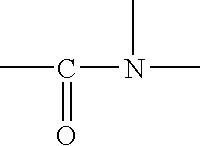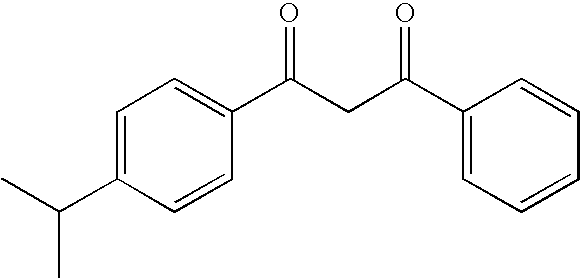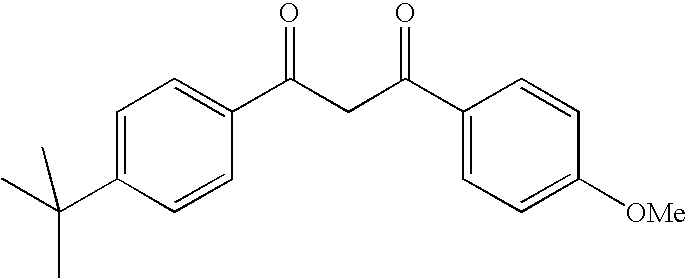Photostable photoprotective compositions comprising dibenzoylmethane and amide oil compounds and a compound that accepts the excited triplet level energy of said dibenzoylmethane(s)
a technology of dibenzoylmethane and amide oil, which is applied in the field of photoprotective compositions for topical application, can solve the problems of skin tan, adverse changes, skin elasticity loss, etc., and achieve the effect of improving photochemical stability (or photostability)
- Summary
- Abstract
- Description
- Claims
- Application Information
AI Technical Summary
Benefits of technology
Problems solved by technology
Method used
Image
Examples
composition examples 1 to 3
[0295]The following compositions were prepared, the amounts being expressed as weight percentages.
[0296]
PhaseCompositionFormula 1Formula 2Formula 3Phase APolydimethylsiloxane0.50.50.5Preservatives111Stearic acid1.51.51.5Glyceryl111monostearate / PEGstearate mixture (100EO)Mixture of cetylstearyl222glucoside, cetyl alcoholand stearyl alcoholCetyl alcohol0.50.50.54 tert-Butyl-4′-222methoxydibenzoylmethaneC12-C13 alkyl benzoate1055N-Lauroyl isopropyl102020sarcosinate(Eldew SL-205 - Ajimoto)2,6-Diethylhexyl0.5——naphthalate(Hallbrite TQ from CPHall)Diethylhexyl—1—syringylidenemalonate(Oxynex ST from Merck)Tris(tetramethyl-——2 (AM)*hydroxypiperidinol)citrate(Tinoguard Q fromCiba-Geigy)Phase BDeionized waterqs 100qs 100qs 100Complexing agent0.10.10.1Glycerol555Xanthan gum0.20.20.2Monocetyl phosphate111Phase CIsohexadecane111Acrylic acid / stearyl0.20.20.2methacrylate copolymerTriethanolamineqs pHqs pHqs pH*AM = active material
[0297]Method:
[0298]The aqueous phase (Phase B) containing all of its...
PUM
| Property | Measurement | Unit |
|---|---|---|
| wavelengths | aaaaa | aaaaa |
| wavelengths | aaaaa | aaaaa |
| wavelengths | aaaaa | aaaaa |
Abstract
Description
Claims
Application Information
 Login to View More
Login to View More - R&D
- Intellectual Property
- Life Sciences
- Materials
- Tech Scout
- Unparalleled Data Quality
- Higher Quality Content
- 60% Fewer Hallucinations
Browse by: Latest US Patents, China's latest patents, Technical Efficacy Thesaurus, Application Domain, Technology Topic, Popular Technical Reports.
© 2025 PatSnap. All rights reserved.Legal|Privacy policy|Modern Slavery Act Transparency Statement|Sitemap|About US| Contact US: help@patsnap.com



